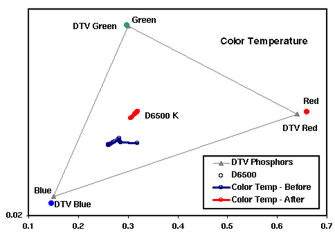Toshiba TW56X81 Rear-Projection Television Page 2
Like a good thriller, though, this story has a twist, which occurs when you flip the Picture Preference mode from normal to theater. As we mentioned, whatever mode you start from is saved into the custom setting with your changes. The theater mode, in addition to having a more-reasonable contrast level, turns on DC restoration, which makes the black level stable with all images. Likewise, this mode defeats scan-velocity modulation, which in turn eliminates the ringing in the image. A quick calibration with Video Essentials had the color levels up and the color temperature down to where they should be. The resulting image was excellent.
In demo scene after demo scene, the image had vibrant colors that were neither muted nor exaggerated. This indicates that the set has an accurate color decoder. The image, when adjusted correctly, was still bright. It didn't waver, bend, or change shape as scenes got brighter or darker—evidence that the set has a strong power supply. Not only does the TV have good DC restoration, but the fact that the black level stayed so deep and dark with all images implies that the set has disabled black stretch, as well. Surprisingly, the normal-mode image has noticeable dot crawl (or jagged color borders between objects), while the theater mode eliminates this artifact altogether. This is a sign of a first-rate comb filter. One thing we noticed was a slight graininess to the image, but the combination of everything else more than makes up for it.
NTSC images are enhanced by the built-in line doubler, which removes scan lines and makes a more solid, filmlike image. The upconverter is probably the weak link in the TV, showing some jagged edges and moiré on fine detail and diagonal lines, but it's at least as good as line doublers used in any other TV. Add a progressive-scan DVD player or an external line doubler, like the $700 iScan by DVDO, and the picture is almost as good as it gets.
I say almost because HDTV sources will look even better. We used the Panasonic digital TV decoder to tune in one of the several stations broadcasting digital signals here in L.A. The picture, although not as sharp as we've seen from larger, more-expensive HDTVs, was still impressive. There was a slight blue halo around fine white details that was minimized but not eliminated with a quick convergence touch-up in the user menu. For the most part, Chuck Henry's Travel Café came across sharp and detailed, and colors (as with NTSC images) were bright and vibrant.
Toshiba has built plenty of great sets in the past, but the TW56X81 is the best we've seen yet. With the ability to please both average users and videophiles, the TV is sure to satisfy any family of users. Add a progressive-scan DVD player and an HDTV tuner, and you'll be watching some of the best images available.
Highlights
• Two wideband component inputs for progressive-scan DVD players and HDTV tuners
• Accurate or enhanced images available at the press of a button
 HT Labs Measures: Toshiba TW56X81 Television
HT Labs Measures: Toshiba TW56X81 Television 
The chart above shows the gray scale (or color temperature) of the Toshiba HDTV and the color points of the display's red, green, and blue tubes. The gray scale measures extremely blue out of the box. After making adjustments using the Photo Research SR-650, the gray scale was close to the industry standard of D6500 Kelvin but drifted slightly. With darker images, the gray scale was fairly accurate; medium-intensity images become slightly red, while brighter scenes become bluer. The red, green, and blue phosphor colors of the three CRTs match or exceed those specified by SMPTE. The light output was approximately 35 foot-lamberts as measured from the center of the high-gain screen.—MW




























































